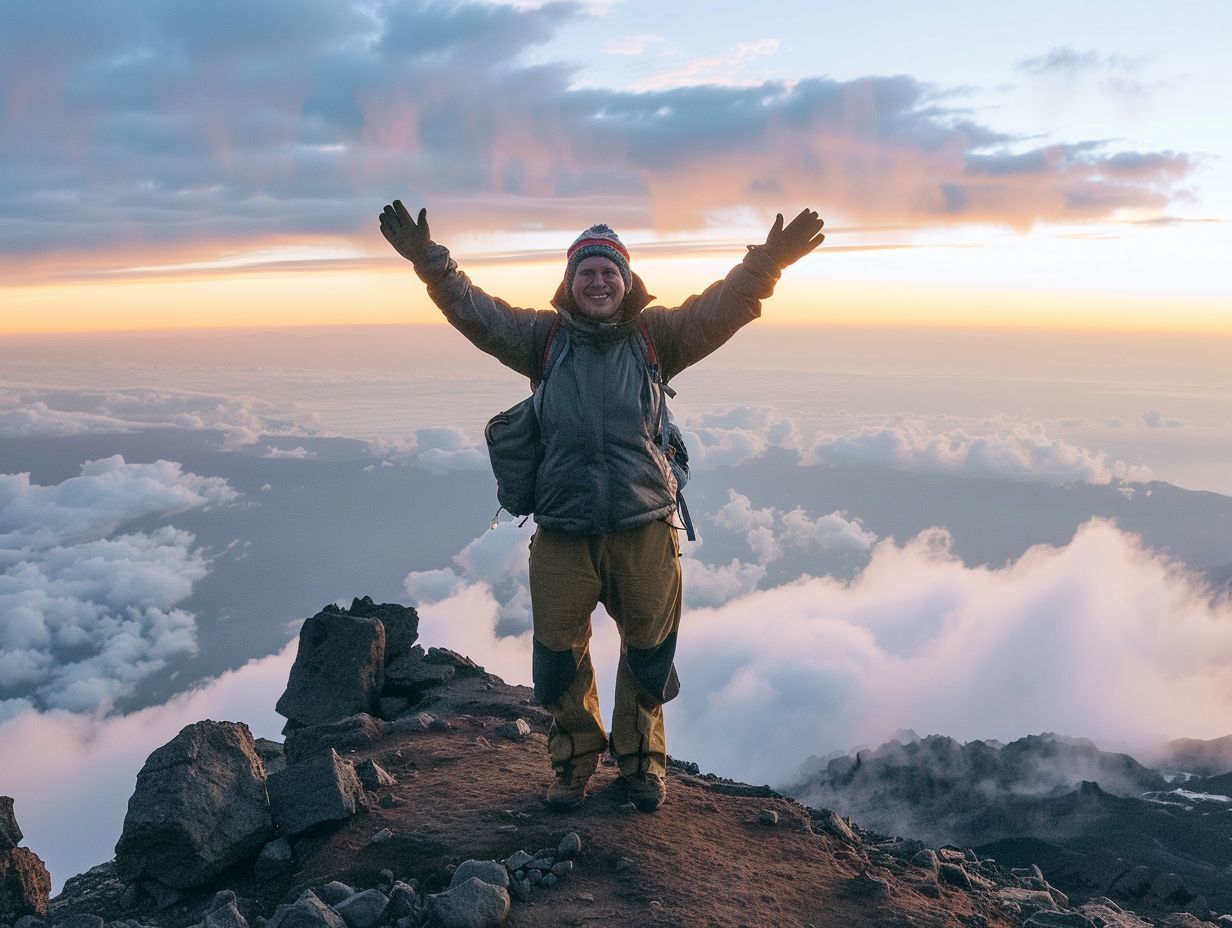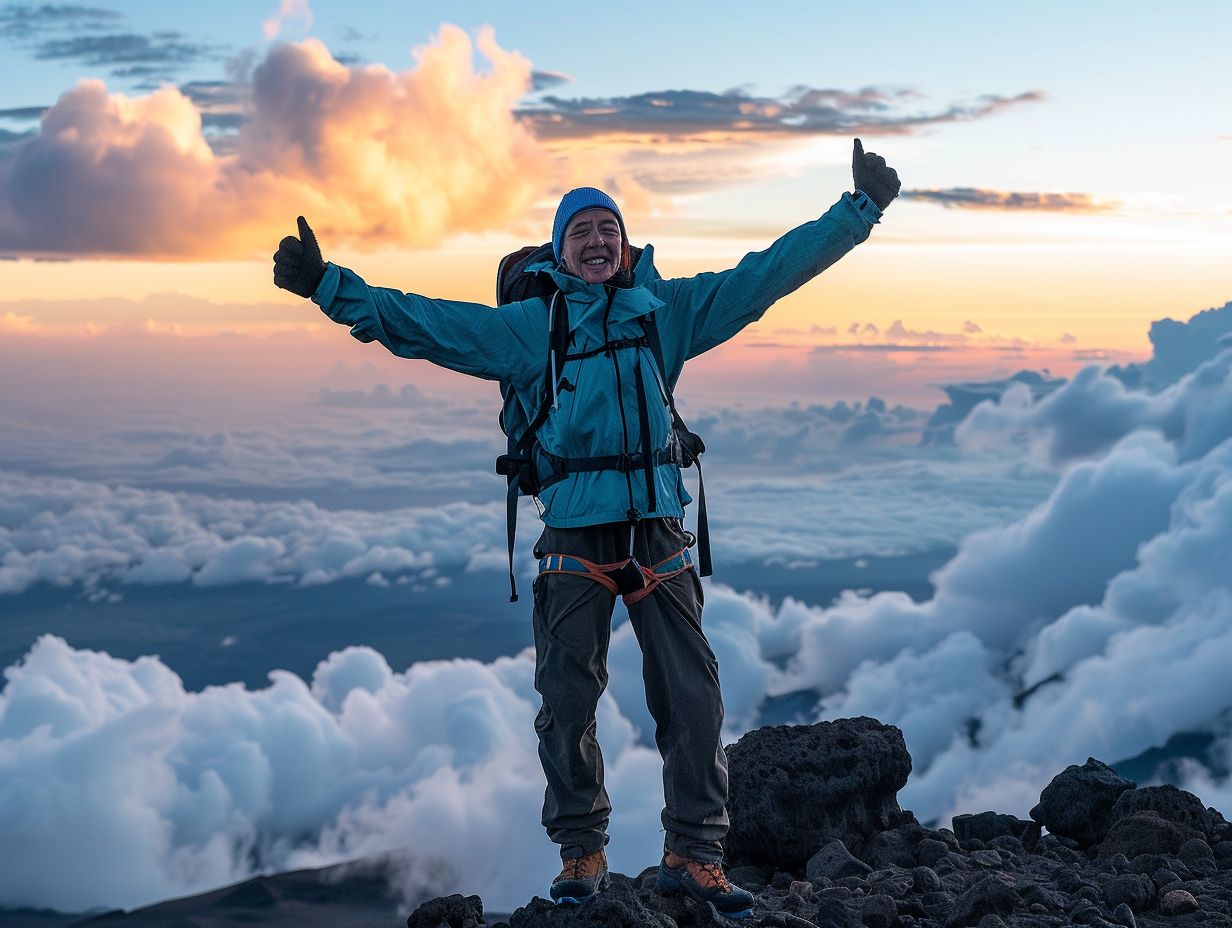
Is 50 Too Old To Climb Kilimanjaro
Are you in your 50s and dreaming of conquering Kilimanjaro?
We will explore the physical and mental requirements, age restrictions, health risks, precautions, best routes, accommodation options, costs, training tips, and safety measures for older climbers.
Whether you’re a seasoned adventurer or a novice looking for a new challenge, we’ve got all the information you need to make your Kilimanjaro dream a reality.
So, lace up your boots and get ready for an epic journey!
Key Takeaways:

- Age is not a barrier to climbing Kilimanjaro at 50, as long as you are physically and mentally fit.
- Proper training, preparation, and choosing the right route are key factors for a successful climb at any age.
- Older climbers should take extra precautions and listen to their bodies to minimize health risks while climbing Kilimanjaro.
What Are The Physical Requirements for Climbing Kilimanjaro?
Climbing Kilimanjaro demands a combination of physical fitness, stamina, and the ability to acclimatize to varying altitudes.
Altitude acclimatization is crucial when it comes to tackling the heights of Kilimanjaro.The human body needs time to adjust to the decrease in oxygen levels as you ascend higher on the mountain.
Proper acclimatization helps prevent altitude sickness, which can range from mild symptoms like headaches and fatigue to more severe conditions.
The trek involves long hours of walking each day, often in challenging terrains and changing weather conditions.
Endurance training, such as cardiovascular exercises and long hikes, is essential to withstand the physical demands of the climb.
To reach the summit of Kilimanjaro, climbers must possess a good overall level of fitness. This includes strength training for the legs and core.
Adequate physical fitness not only enhances performance but also reduces the risk of injuries during the expedition.
What Are The Age Restrictions for Climbing Kilimanjaro?
While there are no strict age restrictions for climbing Kilimanjaro, individuals must consider their age, health status, and physical conditioning.
Age can have a significant impact on a climber’s experience on Kilimanjaro. Younger climbers may have more robust stamina and recovery abilities.
On the other hand, older climbers might face greater challenges due to decreased muscle mass and slower recovery times.Health status is a critical factor to assess before attempting the climb.
Existing medical conditions, such as heart problems or respiratory issues, can be exacerbated by the altitude and physical exertion.
What Are The Mental Requirements for Climbing Kilimanjaro?

Climbing Kilimanjaro necessitates mental fortitude, perseverance, and the wisdom to make crucial decisions during the ascent.
As climbers ascend, they are constantly battling not only the physical demands of the climb but also the mental challenges that come with it.
The altitude, harsh weather conditions, and fatigue can push climbers to their limits, testing their mental resilience like never before.
Each step upwards requires a deep well of determination and inner strength to overcome doubts and fears that inevitably creep in.
At higher altitudes, where oxygen levels are scarce and every breath feels labored, climbers must dig deep into their reserves of mental fortitude.
Decision-making skills play a crucial role in such moments, as the choices made can impact the success and safety of the entire expedition.
The ability to stay focused, evaluate risks, and adapt to changing circumstances becomes paramount to navigate the challenges of the climb.
Thus, reaching the summit of Kilimanjaro is not only a physical feat but a triumph of the mind. It is a testament to the perseverance and unwavering determination of those who dare to conquer.
What Are The Health Risks of Climbing Kilimanjaro?
The ascent brings potential health risks related to altitude sickness, dehydration, and other physiological challenges.
Altitude sickness (AMS), occurs due to the decreasing oxygen levels at higher altitudes, causing symptoms like headache, nausea, fatigue, and dizziness.
Dehydration, exacerbated by the dry mountain air and physical exertion, can lead to serious complications if not addressed promptly.
Proper hydration and nutrition are crucial for climbers to maintain energy levels and prevent fatigue.
Climbers should acclimatize slowly, stay well-hydrated, protect themselves from the sun’s intense rays, and monitor their physical condition.
What Precautions Should Older Climbers Take?
Older climbers planning a expedition should consult with a healthcare professional to assess their physical condition.
It is essential for older individuals embarking on this adventure to have a comprehensive understanding of their health status. A thorough medical consultation will offer insights.
Discussing the potential need for altitude sickness medication like Diamox is crucial to prepare for any altitude-related issues.
Alongside medication considerations, developing a personalized health plan that includes physical fitness routines and proper nutrition.
What Are The Best Routes for Older Climbers?
Older climbers seeking a less strenuous yet rewarding Kilimanjaro experience may find routes like the Lemosho or Rongai routes suitable for their ascent.
These routes are considered ideal for older climbers due to their gradual inclines, allowing for better adaptation to altitude changes.
The Lemosho route, known for its scenic beauty and diverse landscapes, offers a more secluded and peaceful trekking experience.
On the other hand, the Rongai route, approaching Kilimanjaro from the north, provides a different perspective and often attracts fewer crowds.
This route’s gentle slopes offer a more manageable climb, giving older climbers the opportunity to take in the breathtaking views at a comfortable pace.
What Are The Accommodation Options for Climbing Kilimanjaro?
Climbers on Kilimanjaro can choose between camping in tents at designated campsites along the routes or staying in lodges.
For climbers seeking a closer connection to nature and a true wilderness adventure, camping in tents is often the preferred choice.
The campsites along the routes provide basic amenities like toilets and communal areas, allowing climbers to rest and rejuvenate.
On the other hand, opting for lodges while climbing Kilimanjaro offers a different kind of experience. These accommodations provide more comfort with cozy beds, hot showers, and meals prepared.
Staying in lodges may take away some of the raw wilderness appeal that camping offers.
What Are The Pros and Cons of Camping vs. Lodging?

The decision between camping and lodging on Kilimanjaro involves considering the trade-offs between the wilderness experience and comfort.
When opting for camping , climbers get to immerse themselves fully in the natural environment, waking up to breathtaking views of the mountain.
This experience fosters a sense of adventure and self-reliance, enhancing the overall thrill of the ascent.
Camping allows for a more flexible schedule, with the freedom to choose camping spots along the route based on preference or condition.
The rugged conditions of camping might not suit all climbers, with limited access to facilities, which can impact physical rest and recovery.
What Are The Costs of Climbing Kilimanjaro?
The expenses associated with climbing Kilimanjaro encompass guide fees, park fees, accommodation costs, travel arrangements, insurance premiums, and agency charges.
Guide fees typically range from $1,000 to $2,500 depending on the level of services provided and the duration of the climb.
Park fees, which include entry to Kilimanjaro National Park, vary between $60 to $100 per person per day.
Accommodation costs can vary greatly between budget camping options and luxury lodges along the route.
Travel arrangements, such as flights to Tanzania and transportation to the mountain, add another significant expense to the overall budget.
Insurance premiums, covering medical evacuation and trip interruptions, are essential for climbers undertaking such a challenging expedition.
The agency charges cover logistical support, equipment rentals, and administrative fees, averaging around $1,000 to $1,500 per person.
These various costs need to be factored in when planning a Kilimanjaro adventure to ensure a smooth and financially prepared expedition.
What Are The Training Tips for Older Climbers?
Older climbers preparing for a Kilimanjaro expedition should focus on a training regimen that enhances cardiovascular fitness, builds stamina, and strengthens leg muscles.
Cardiovascular fitness is crucial for older climbers as it improves the efficiency of the heart and lungs, allowing them to cope with the altitude.
Endurance training plays a vital role in preparing them mentally and physically for the sustained effort required during the climb.
Incorporating specific exercises like hiking, stair climbing, and cycling can help condition the leg muscles.
What Exercises Should Be Included in Training?
Training should include a mix of cardiovascular exercises like hiking and running, strength training for leg muscles, and joint-friendly activities.
Cardiovascular exercises such as cycling and swimming are also beneficial for building endurance and stamina.
For strength training, focusing on exercises like squats, lunges, and calf raises can help strengthen the leg muscles.
Incorporating yoga or Pilates into the training regimen can aid in improving flexibility and balance.
What Are The Recommended Training Duration and Frequency?
For optimal preparation, older climbers should engage in training sessions at least 3-4 times a week, with each session lasting between 60-90 minutes.
Consistency in training is crucial for older climbers gearing up for the ultimate challenge of Kilimanjaro.
It’s recommended to gradually increase the intensity of workouts and include a mix of cardiovascular exercises, strength training, and flexibility routines.
Incorporating rest days in between training sessions is vital to allow the body to recover and adapt to the physical demands of climbing.
This will help prevent overtraining and reduce the risk of injuries, ensuring a sustainable progression towards peak performance.
What Are The Safety Measures During The Climb?

Ensuring safety during the climb involves adhering to proper acclimatization, maintaining a steady pace, listening to the guide, carrying essentials, and being prepared for medical issues.
- Acclimatization is crucial as it helps your body adjust to the altitude.
- Climbers should ascend slowly to allow their bodies to adapt gradually to the decreasing oxygen levels.
- It is recommended to plan rest days at various altitudes to aid in acclimatizing properly.
- Following the guide’s instructions is vital as they are experienced in the terrain and weather.
- Descent strategies are equally important, as coming down too quickly can lead to altitude-related illnesses.
- Gradual descent with breaks at lower elevations can help prevent issues such as pulmonary or cerebral edema.
- Make sure to drink plenty of fluids, eat well, and continue monitoring your health throughout the descent.
- Being medically prepared involves carrying a first aid kit .
- Adequate insurance coverage that includes emergency evacuation is essential for unforeseen situations.
Climbers should be aware of the potential risks and symptoms of altitude sickness, and always communicate any health concerns to the guide.
Frequently Asked Questions
1. Is 50 Too Old To Climb Kilimanjaro?
A: Yes, it is possible for a 50-year-old to climb Kilimanjaro. Many people in their 50s have successfully summited the mountain.
2. What are the physical requirements for climbing Kilimanjaro at 50?
A: While climbing Kilimanjaro at 50 may be more challenging than in your younger years, it is still achievable with proper training and preparation. You should be in good physical shape and have a high level of fitness.
3. Are there any age restrictions for climbing Kilimanjaro?
A: There are no specific age restrictions for climbing Kilimanjaro, but climbers over the age of 50 may be required to provide a medical clearance from their doctor.
4. What are the risks of climbing Kilimanjaro at 50?
A: As with any physically demanding activity, there are risks involved in climbing Kilimanjaro at 50. It is important to consult with your doctor and properly train and prepare to minimize these risks.
5. What is the success rate for 50-year-olds climbing Kilimanjaro?
A: The success rate for 50-year-olds climbing Kilimanjaro varies, but it is generally higher for those who have trained and prepared properly. It is also important to choose a reputable and experienced guide or tour company.
6. What can I do to prepare for climbing Kilimanjaro at 50?
A: To prepare for climbing Kilimanjaro at 50, you should focus on building your endurance and strength through regular exercise and training hikes. It is also important to do research and talk to experienced climbers to understand the challenges and requirements of the climb.